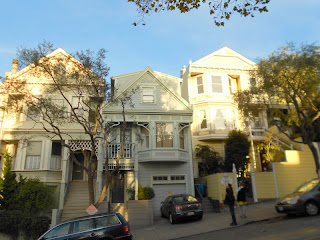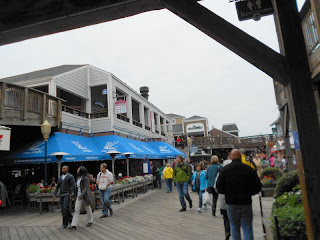- The San Francisco Bay was one of the last major features of the California coast to be discovered by Spanish and other European explorers. Because the Golden Gate is so narrow and often shrouded in thick fog, their ships simply missed its existence. It wasn't until 1776 that he Spanish military arrived.
- The modern history of San Francisco began with the Gold Rush with gold-seekers sailing in from all over the world. The 19th century saw incredible growth and development.
- San Francisco was a major military town in the mid-20th century, especially during the Pacific campaigns of WW2 with thousands of troops being shipped out from Angel Island and the Presidio.
- In the 1960s it became a haven for flower children, anti-war activists, civil rights leaders and gays.
- The single most famous event ever to occur in San Francisco was on April 18th 1906 when the city was struck by an earthquake of 7.8 magnitude.
- In 1989 another earthquake registering 6.9 on the Richter scale struck, right in the middle of a local football derby between San Francisco and Oakland in the World Series.
DAVID:
We had a fantastic weekend in San Francisco, and not least because of the welcome and hospitality of Sue's cousin David who we stayed with in his home in the hills overlooking Oakland.
David is Sue's first cousin (his father Brendan and Sue's mother having been brother and sister). David was born and brought up in East Acton and Hammersmith, not far from Harlesden where Sue lived, before moving with his family to live in Ireland when he was 15. After graduating, he moved to America 32 years ago.
We'd last met 40 years ago at Sue's 21st birthday party! Over the years we'd heard, from another cousin Colette, about his annual trips to Ireland with his children to visit his parents , so when we decided a year ago to make this trip Sue had got in touch with him.
We'd agreed to meet in Crogan's, an Irish bar (where else??) in the village of Montclair not far from David's home. He'd at least seen what we looked like from our pictures on the blog, but all we had to go on about him was that he looked like his mother, only taller!! We only accosted one bewildered man who wasn't David before we met up.
On Saturday David drove us to and around the city. It would have been well-nigh impossible to do this as a tourist in less than a week so it was a real bonus to be with someone who both knew their way around but also could fill us in on what we were looking at. We saw so much that we knew we would not have seen otherwise.
Just some of the places we saw:
- Twin Peaks: 2nd highest point in the city, dividing it north-south. (We took a video: to be published later.)
- Golden Gate Bridge: see later in this blog.
- Chinatown
- Haight Ashbury: the hippy capital of the 1970s
- Financial District and SOMA (south of the of the market area)
- Transamerica Pyramid: the single most recognisable land mark on the skyline, designed originally to look like a little tree. It's been the centre of much controversy as many feel it is out of keeping with the rest of the city architecturally.
- If / when there is another quake, it's been estimated there will be c.10 feet of glass deposited on the streets from the buildings!
- SOMA, not Silicon Valley, is now where most start-ups are.
- The Painted Ladies: the beautifully restored and colourful traditional Victorian houses that abound in the city.
- North Beach: where we stopped for a delicious Italian lunch. This was both an Italian and Irish area originally.
- Mission: largely a Latin American area.
- The Presidio: a military installation since 1776 when the Spanish established their El Presidio del San Francisco fort on the site. The US army took the site in 1848. It became a national park in 1994.
Steve was in heaven as David had recorded the qualifiers for the Korean Grand Prix for him to watch on Friday evening, and the Grand Prix on Saturday. And Sue was in heaven watching the first 3 episodes of the new series of 'Homeland'.
And....of course.....we did have a few bevvies in David's local bar, also Irish would you believe.
THANK YOU!! THANK YOU!! THANK YOU!! THANK YOU!!
PIER 39 & FISHERMAN'S WHARF:
On Friday, before meeting David, we headed for what is a tourist mecca, fun but, according to the guide books, 'avoided at all costs by locals'. Steve had been here 20 years ago and had fond memories of it, and wanted Sue to see it too. Fisherman's Wharf's not an actual wharf or single pier, but an area that sprawls along the waterfront and inland several blocks. It was where 19th century Italians came to work: they were a big part of the fishing fleet that provided San Francisco with its legendary supply of fresh seafood.
Be warned: if you're planning on going, parking is very expensive and the crowds can be large.
In particular, we were headed for Pier 39, one of the most-visited spots in San Francisco, renowned for its fish and seafood restaurants.
Strolling along the pier you get a good view of the ships that cruise the Bay leaving from Piers 39 and 41.
Restaurants abound. We opted for the 'Pier Market' which was a good choice......
.......the fish was delicious and the view was great.
Sunday morning we hit the city on our own. First stop was Oakland to catch the 9am ferry to Pier 41.
Driving there, despite David's detailed directions, was a bit hairy in places, not least when an Amtrak passenger train roared past us only feet from the lane we were driving in (no barriers etc. between us!).
We arrived at 9.45 so had nearly an hour and a half before the cruise. Time for breakfast at Boudin's (www.boudinbakery.com) which makes the most famous sourdough in the city and is a Pier 39 institution.
We hadn't been planning to, but we couldn't resist going into the Musee Mechanique, a privately-owned collection of over 300 games machines dating from the 19th century. Great fun!


Outside was the USS Pampanito.
BAY CRUISE:
- Golden Gate Bridge:
The fog that blows in over the bridge is legendary, but can mean viewing the bridge unobscured is unpredictable.
 |
| Luckily, when we saw it on Saturday it was a beautiful clear day...... |
 |
| .......but by Sunday the fog had taken a grip. |
- Alcatraz:
- the 22-acre island was discovered by a Spanish explorer in 1775 and named 'Isla de los Alcatraces' (Island of the Pelicans) reputedly for the colony of pelicans roosting there.
- The US military soon recognised the island's strategic importance and by 1854 the Army had established a fortress as part of its harbour defence, then converted it into a military prison during the Civil War.
- In 1934 the military closed down their prison and handed over the island to the Department of Justice.
- Alcatraz was turned into a maximum security prison housing a new kind of prisoner: Depression-era gangsters., 'public enemies' like Al Capone, 'Machine Gun' Kelly and Robert Stroud (the 'Birdman of Alctraz').
Officially, during its 29 years as a federal prison there were no successful escapes but at least 4 convicts disappeared and have never been accounted for.
The prison was closed in 1963.
In 1969 a group of Native Americans occupied Alcatraz for 19 months, claiming the abandoned island as 'Indian Land'.
- Bay Bridge:
It's a double-decker bridge, and in the earthquake of 1989 part of the upper deck fell on the carriageway below, killing many.
- Sea Lions:
- Angel Island:
The cruise ended with a closer look at the shore line.
 |
| But for the constant threat of earthquake, how would this look? Like Hong Kong perhaps? |
 |
| Shouldn't this be in New Orleans? |
 |
| This massive cruise liner was coming in with 2 minute tugs attached. |
CABLE CARS:
We couldn't come and not ride the cable car!
They are the brainchild of Andrew Hallidie who designed them to be a safer alternative for travelling the steep, often slippery hills of San Francisco. They ran as regular public transport from 1837 to the 1940s, when electric trolley-buses and buses began to dominate. Dedicated citizens, especially 'Cable Car Lady' Friedel Klussman, saved the cable car system from extinction.
We got on at Fisherman's Wharf and rode through Chinatown, down Powell Street, through Union Square to Nob Hill.....and back.
 |
| They have to turn them round at the end of the route. |
HYDE ST. PIER:
We turned up here too late unfortunately to get on the ships.
UNION SQUARE:
We've been very good this trip in not going into shops too often, but Sue did persuade Steve to take a peek inside Bloomingdale's: pure research, of course, to compare US and UK department stores.
We both agreed that far more interesting were the beautiful 1920s and 1930s buildings, the result of the rebuilding necessitated by the 1906 earthquake.
WHAT'S IN A NAME?
Sue (nee Farrell) was keen to know how this street got its name.
Click on the link below to find out.
Then it was time for the 6.45p.m. ferry back to Oakland.









































1 comment:
fab photos!
Post a Comment